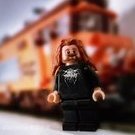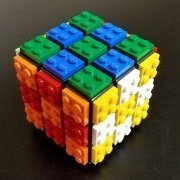Search the Community
Showing results for tags 'hopper'.
Found 9 results
-

(MOC) Portuguese Cereal/Grain Train - Hopper Consist (Loco+waggons)
Sérgio posted a topic in LEGO Train Tech
Hi guys. Some new stuff. Locomotive is an EuroSprinter from 2007 (pre-Vectron) the full name is Siemens ES46B1-A It has the Old CP Carga Livery before they change to Medway, I prefer this one. The most challenging part was making the big logo on the sides with bricks. The Lego model is based on Beck's with and TBX Nicolas Enhancements Vectron It has custom M-size wheels, actually, I have two packs, one 3D printed by Brickthebrick with the brake disc and another that is a Mold injection prototype from HA Bricks. I use the 3D printed ones for photos and static exhibitions and the mold injection ones for running, the 3D are OK for running as well, but the HA Bricks wheels are better for running 2 Powerfunctions L motors and a MouldKing Battery Hub (its more compact and versatile than the LEGO PU) but I will change to Buwizz as soon my wallet gives me permission :P Funny easter egg, most of the technical info on the decals are also in Scale as well :) The waggons are Portuguese hoppers TDGS used to transport Cereal/Grain Each waggon has around 800 parts, and they are small but with a lot of details, I made 8 waggons (the red wheels are not from Lego), the real train has 18 waggons, but I don't have more room, money or patience to make another 10 :P The Entire train has 2,20meters long -
A grainy bit of my childhood history revived - Grain Elevator MOC from 1999 finished
Murdoch17 posted a topic in LEGO Train Tech
This grain elevator model was made by my dad in 1999 / 2000. Like most of his MOCs from that time (the single-stall version of his train shed, Bridge on the River Baseplate, the factory in sand red), he built it before he had a BrickLink account. With this one he never finished it 100%, probably due to having kids (including me) tearing it down and scattering parts every other weekend while he fixed it during the week. Eventually, he put them up out of reach except for special occasions such as the two weeks bracketing Christmas. This vintage model has been used by our family for layouts at his house at Christmas and other times for a long while, throughout most of my childhood up to 2015 or so when we stopped doing a tree + floor layout. He eventually gifted it to me about a month ago because he built the Brick Train Depot version and it is better / bigger by like double in size. (I've been asking for it in one way or another since early 2020 when he built the BTD model.... took me almost a year and a half, but I got it at last!) But before we get to the revamped version, here is the photo of it in it's pre-restoration state. This was from the day I got it, September 12th 2021. It was actually dirty in places, missing several parts, slightly yellowing, and very dusty. ...and here it is now! It's still got some yellowing, and slightly dirty despite my best attempts to clean it. (I don't have any cans of air at my place, so it might be a while until that's done!) The model has finally been completed after ~22 years, with the conveyor belt added and missing old gray parts added in. I added tan baseplates for the bottom, as it fits with the rest of my buildings better. My dad always wanted a conveyor put in to his elevator haul grain to the dump-chute to load his six blue 4536-style hopper cars. Well, it's no longer his grain elevator, but it's finally got a conveyor! The white handle, which can be turned to make the belt move. This view looks down the chute into the area where the grain is stored before being dumped into the hopper cars I haven't made yet. Looks like someone forgot to close one of the two hatches all the way! These two finger-hinged doors hold the grain back until it is needed to be loaded. But what's a elevator without something for it to load? These five single-bay grain hopper cars plus the matching caboose are (eventually) going to be built for the vintage grain elevator MOC my dad gifted me recently. The engines that are going to pull them will most likely be the two Santa Fe bluebonnet F7 units I have lying around. Also, the bay on each car can still empty out as designed in the 1991 set (4536 Blue Hopper car) this model was taken from. Here is the Bluebonnet units I have already constructed. That's all I got about these MOCs, any thoughts? Comments questions, suggestions, and complaints welcome!- 3 replies
-
- grain elevator
- 1999
- (and 6 more)
-
2-10-0 "Austerity" class steam locomotive + UK freight train - real life finished MOC!
Murdoch17 posted a topic in LEGO Train Tech
The War Department "Austerity" 2-10-0 is a type of steam heavy freight locomotive that was introduced in WWII in 1943. It was designed by R.A. Riddles, the same man who latter went on to design the British Railways 9F 2-10-0 type. I've backdated my 1950's 9F type into this 1940's Austerity class by removing the side smoke deflectors and changing around some small features here and there. As most of this engine still existed as-built from my previous 9F build from 2014 (that itself was inspired by @ScotNick's model of Thomas and Friends' 9F-type engine Murdoch) or so, I just needed to get wheels, a tender draw-bar connector, pistons / side-rods, and the little bit of parts to convert it to a Austerity type. The tender has "BR" printed on it in 1 x 1 tiles, standing for British Railways, as this engine was placed into service with the newly nationalized rail network after service with the War Department during WWII (around early 1948). However, it still is carrying it's War-time grayscale color scheme at this point in the early 1950's, lending to it's nickname the "Gray Ghost". The cab of the engine, with firebox in the middle. In the real world, the Austerity 2-10-0 class engine was designed and built during the Second World War as an British export locomotive, with some going as far away as Greece, the Netherlands, or Syria, while a few stayed in the UK to be worked by the War Department, and later, British Railways. All but three of the ones from the UK (of which one was owned by the Longmoor Military Railway) survived mass scrapping in 1962 and were preserved, while a fourth was brought back from the Netherlands and also survives. (There are also a few derelict versions in Greece, while a museum in the Netherlands has an engine as well, albeit in much better condition than the Greek locos.) All credit for the BR plank wagon model seen in the picture above goes to @Pdaitabird, who designed them. See here for an awesome step-by-step tutorial by the original builder of the BR plank wagon. Original design by Flickr user Fireglo450 in 2013, revised by me in 2020. See here for the original inspirational model. Here we see the whole gravel train at an "on-it's-side" view for maximum viewing. This train is destined for the Gravel loading facility where it will be loaded with crushed stone for either rail ballast or concrete works projects elsewhere in the country. As usual, comments, questions, and complaints are always welcome!- 4 replies
-
- guards van
- plank wagon
- (and 14 more)
-
I downloaded LDD just 48 hours ago and got right to work on designing a hopper car. Well eight hoppers to be exact. I know they just look like simple color changes but the first one took me the better part of eight hours. Then I spent many more hours getting familiar with groups and templates. Simultaneously I hand keyed them into Bricklink and spent many more hours getting them from about $90 per car to the to $40-$50 range with careful parts and color editing. So now I have a choice to make, I'm going to order parts for three cars and want your input. Which colors combinations do you like the best and why? Most favorite and least favorite? I also welcome any opinions, or suggestions. They are 24 studs long and I won't be making any changes to their length. Thanks in advance, hope you like! -Scott Link to .lxf file. https://drive.google.com/file/d/1e9qqypkfY-aygmPB61na6wNFS1eNDONc/view?usp=drivesdk Link to a high quality pic. https://photos.app.goo.gl/MgeiD3S4d71siK5c2
-
Functional grain elevator with working hopper car (4536 MOD) and ALCO diesel A+B units
Murdoch17 posted a topic in LEGO Train Tech
(I thought I had made a topic for this model by itself, but i can't find it. All I could find was it in a compilation thread from 2014.) I have recreated this grain elevator designed by my father way back in 1999. The building was built for the loading of hoppers like set 4536 (1991's Blue Hopper Car) or 10017 (2001's Hopper Wagon). This building has never been really well done officially, but it was touched upon in 3677 (2011's Red Cargo Train). However, grain hopper cars have been made at least four times in official sets, with the fourth model being in set 60098. (Heavy-Haul cargo train) I enlarged the opening for the filling of the grain cars by two studs width-wise so that larger engines and cars can fit through, such a steam engines with working side-rods. The building features a handle on the other side or operating the conveyor belt. The handle turns the conveyor belt to drop 1 x 1 round bricks into the funnel and the hopper car below. Though if it gets turned the wrong way, they drop into the bowels of the building to pop out of the bottom of the building where the base-plate would go, onto the table top itself. Here we see the hole I left in case "grain" went the wrong way on the conveyor belt, so it can fall out the bottom and not get stuck inside the model. This is an updated red version of set 4536 (Blue Hopper Car) from 1991. This green version uses a click hinge and platform to dump 1 x 1 round bricks out of the bottom of the hopper. The diesel locomotive model was inspired by Valgarise and his model called "Invencible".(see it here ) It looked like an nice big ALCO model so I copied it and built a matching booster unit in green as seen above. (although originally it was in black with a red base stripe when I first built it) The front unit where the engineer sits is called a Cab (or A) unit, while the trailing unit is called a Booster (or B) unit, though they can be used in more groups than just two, like as an A-B-B-A set as used on the Santa Fe Super Chief. For my purposes, I only use a A-B setup at most. Here is the original grain elevator that inspired my model. It was built around 1999-ish by my father. Comments, Questions, & complaints are always welcome, and the elevator model (plus a half-dozen green hopper cars) should be built by Christmas / beginning of 2019. As you can see, the engine units have already been built. Any thoughts? -
Shay geared steam locomotive and silver ore mining train - MOD of a MOC
Murdoch17 posted a topic in LEGO Train Tech
This type of geared type loco is called a "Shay" (specifically a type "A", which means two pistons and two trucks) and were named after their original inventor of the type, Ephraim Shay. These loco's could only go about 20 miles per hour (or about 32 Kilometers per hour, if that's your thing) at top speed, and were very steady on rough track, hauling logging and mining trains up grades that would easily stall conventional steamer types. You can read more about Shay geared steam locomotive's at Wikipedia. Please NOTE: The design of the original Shay I redid into my version was by Stephan Pakbaz over on Flickr, as seen below. (His LDD file allowed me to build my version) as seen here. The 1 x 1 tiles on either side of the coal bunker are supposed to be printed with the number "4" The Shay type only has pistons on one side, with the other side being kinda sparsely decorated. Usually, their would be various accessories and such on this side, but i liked it better devoid of any clutter. The Shay geared steam loco bends in a odd way... but at least it works. NOTE: The angle shown is quite a bit more severe curve than the loco will ever have to handle.... but it looks pretty cool! This raw ore car was modeled after a custom Brick Link item by @wildchicken13 except mine is narrower and uses two wheels for a Wild West flair. You can see the original item that inspired me here. The caboose follows my standard pattern for my Western trains, with only a few color swaps and a missing cupola on top to set it apart from the others. Here we see the mining train consisting of four silver ore cars and a caboose, without the Shay. This is my latest (and most likely last) Western styled train, and it will join my other four steamers and their trains in my Wild West collection sometime later in 2018. (The reason I say "last" is that I've run out of railroad-related ideas for my Wild Western layout and am planning on focusing on the updated Native American camp, revised Fort Legoredo and the remaining frontier town buildings after this.) As you may have suspected, the ore the mining train holds comes from my well-protected silver mine, which can be seen in it's own topic. ...and as usual, comments, questions, complaints and suggestions are always welcome! -
One small leap for froggy, one giant leap for frog-kind. :)
-
Hi EB! I haven't posted in a long time, but I have actually been building stuff. I promise. I had been looking to put together an american freight train for some time now: I originally thought I could get away with building a long articulated well car (which would make up the entire length of a practically sized lego train), but the well car has proven to have more restrictions and less reliability than I would have liked, and as such it was time to build some regular freight cars. Tank Car All of these freight cars were actually designed in maybe 2014, but at the time I did not actually intend to build them, preferring the aforementioned well car instead. This tank car was completed first because I was able to acquire almost all of the parts through my local LUG. The only expensive parts were the 8x8 dishes on the ends, which are apparently quite rare. As much as I hate to be imprecise, the car is a little bit of a freelance: I did work off a drawing to get the proportions, but I apparently could not find a photo or model of the thing in the drawing, so the greeble around the the dome and platform is a bit of a guess. The ladders are also a bit disproportioned, but that is more of a convenience. This car probably has the most interesting construction of the three here: I wanted to use the various 8-wide circle parts, but I did not want them to make up the load-bearing structure (so you can't pull the car apart). Therefore the load-bearing structure is actually a Technic frame that kind of moves up and down such that the top and bottom set of circle parts can connect at alternating bulkheads. Flat Car Like the tank car this is a little bit of a freelance, but I really wanted a flatcar such that I could put random stuff on it, and modern flatcars at our scale are far too long to run on R40. I found two models for reference, and I believe my drawing is for the bottom one, but the car itself really takes more from the top one. This one was actually the toughest one to build. As I designed it in 2014, there wasn't nearly enough structural integrity and the wheels would easily rub on various other parts in curves. It took me quite a few iterations to increase the structural integrity to an acceptable level without compromising the overall appearance of the car (mainly not making it too tall). As you can see the details of the final design look nothing like the details on my original LDD build. Build-wise, the key to making it structurally sound was to make the studs-out sides the load-bearing element, and the difficulty was doing that while still giving the trucks enough clearance to pivot fully in an R40 curve. If you press on the car in a turn there is still a but of scrubbing, but for now I consider that acceptable. Hopper Car Unlike the other two, this car is actually based solely on a specific model! It is the latest one to be completed, and I think it is actually my favorite of the lot. It took me a while to get around to it one because I thought it would need a lot of parts, but it was mainly just the 1x2 rails (something like 100 of them) and they were relatively cheap. Construction is mainly studs up for the chassis and studs forward/backward for the sides. Each side is a studs forward and a studs backward section held together with rails on the top and bottom with some additional SNOT needed to go around the ends. It's probably the sturdiest of the three cars, but also the heaviest. Well that's it for now. There is a full gallery with a few more pics if it ever gets moderated. I do have a new locomotive in the works too, and it will be interesting.
- 11 replies
-
I want to build up a set of hopper cars for use at my LUG's next display, and it just so happens that I have six of the 6x28 train bases in orange from my Horizon Express teardown. Even better, they have a couple of 2x2 holes in each to allow cables to pass through, which means I can potentially use them as working hopper cars! Here's what I have so far: Having tested this with a small hopper built out of random bricks and the 1x1 round transparent plates drawer in my collection, the pieces should flow out quite nicely. The problem is the mechanism that will keep these closed and then allow them to be opened again once the hoppers are to be unloaded. So far, I have a device that will keep the doors closed with one of the red Lego pulley bands: ...But that's not really the solution I'm looking for. I'd like something that will operate both doors at once, and lock in either the open or closed position. In addition, I'd also prefer that it operates with as little force as possible, and doesn't require the removal or insertion of any pins - I'd love something that can be pushed over an unloading pit and automatically dump as it passes over, then close up again where it can be taken to the loading station. Oh, and I'm limited to a 4x8x3ish space as well, due to the wheelsets. Shouldn't be too hard for someone with more experience than me, I think... Any ideas?



